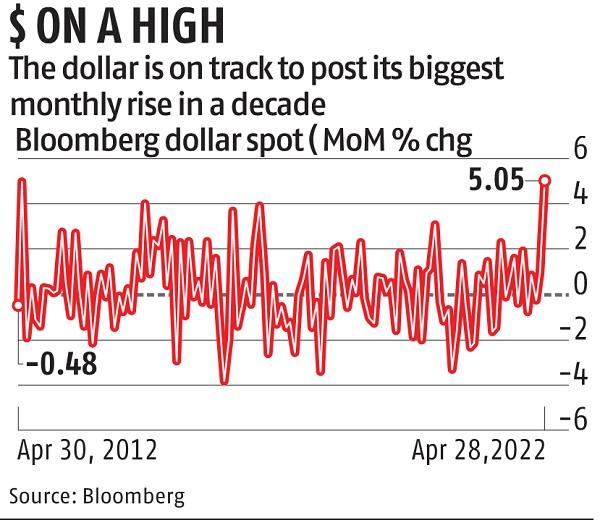‘Dollar is king’ mantra rings across currencies as yen drops to 20-year low
The ascendant US dollar headed for its best month in a decade, as renewed yen selling cemented the greenback’s strength against major peers.
A Bloomberg gauge of the greenback climbed to its highest level in nearly two years and has risen 4.5 per cent this month, set for its best performance since May 2012. The yen fell further against the dollar, tumbling to a two-decade low, after the Bank of Japan (BOJ) kept interest rates at rock-bottom levels and defended its easy monetary policy. That contrasts with a Federal Reserve that has signalled aggressive rate hikes to combat inflation.
“It’s clearly a ‘US dollar is king’ world,” said Mingze Wu, a currency trader in Singapore at StoneX Group. “The dollar will continue to strengthen globally as long as rest of the world does not keep up in matching interest-rate hikes.”
The US currency has seen broad gains against Group-of-10 counterparts this week, hitting a five-year high versus the euro and the strongest level since July 2020 against the pound, ahead of next week’s Fed meeting. Policy makers are expected to deliver a 50-basis-point rate increase, following a quarter-point hike in March.

Widening interest-rate differentials between the US and other countries, as well as global recession risks and the Ukraine war are bolstering sentiment on the dollar, Wu said.
Yen freefall
The Bloomberg Spot Dollar Index climbed to as high as 1,250.01 on Thursday, and was up 0.4 per cent as of 10:23 am in London. The dollar gained 0.3 per cent to $1.0529 per euro, and extended its advance to 2 per cent versus the yen.
The US currency has been buoyed partly by its Japanese peer, which has been in freefall this year. The BOJ said it would carry out fixed-rate bond buying every business day as part of its stimulus measures. As expected, it kept its yield curve control settings and the scale of its asset purchases unchanged, according to a statement Thursday.
While Japan’s consumer prices are also rising due to higher import costs, the central bank has said it won’t change policy until inflation is stable above its 2 per cent target.
Japan’s government bonds rallied following the BOJ decision, with the 10-year yield falling 2.5 basis points to 0.215 per cent. The 30-year yield dropped by 1.5 basis points to 0.96 per cent. The gap between 10-year Japanese and US bond yields widened to the most in three years.
A widening trade deficit has also meant more yen flowing out of the country to pay for dollar-priced goods. The divergence in yields and trade has outweighed efforts from government officials to pare back the currency’s slide. The market’s focus on rate differentials was highlighted on Thursday by the jump in the Swedish krona after a surprise quarter-point rate hike from the central bank, which signalled it may deliver up to three more hikes in 2022.
In Asia, the Korean won and Chinese yuan came under pressure, with the latter tanking more than 1 per cent in offshore trading. “Selling incentive is so strong that it is impacting other currencies through dollar buying,” said Daisuke Karakama, chief market economist at Mizuho Bank in Tokyo.